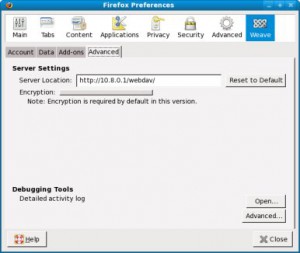Notebooks are usefull things, you can take them with you and your office is where ever you are. I am currently switching to a new notebook and that is sometimes a little bit painful. It takes days to get all software and settings to work as it was on the old one. You know what I mean?
Over the last years I started to use IMAP for mails and subversion for code and other snippets to put most of the things I need to a central server. But I have found no solution for bookmarks and stuff like that. Yea, I know, there are several online services where you can store bookmarks and share them with other people. For security reasons I want to store my bookmarks on my own servers.

For that purpose Mozilla Weave is exactly what I am looking for! It is a Mozilla Firefox Plugin and stores bookmarks, browsing history or saved passwords on an WebDAV Server. Mozilla also provides an public WebDAV service and currently they have reached their account limit and do not allow new registrations. But if you are going to use your own WebDAV server you can still download the XPI package from that location.
I configured Apache as a WebDAV server like that:
Alias /webdav/ "/var/www/webdav/" <directory /var/www/webdav> DAV on AuthType Basic AuthName "WebDAV Storage" AuthUserFile /etc/httpd/passwd/passwd.dav require user frank Options Indexes </Directory>
After installing the weave plugin you have to change the settings of the WebDAV server to use:
